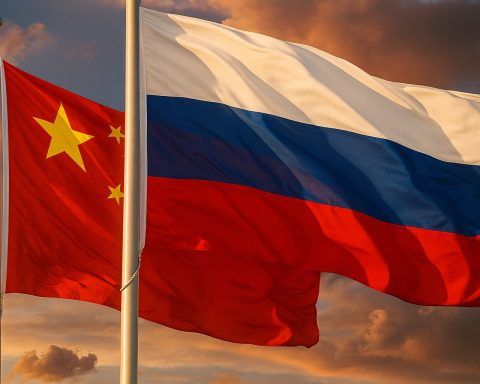- Ukraine’s strikes have hit oil hard: President Zelenskyy says Kyiv’s long-range attacks have cut 20% of Russia’s refining capacity [1].
- Massive campaign: Open-source analysts confirm 21 of Russia’s 38 major refineries have been struck since January 2025 [2] [3] – a pace nearly 50% above all of 2024.
- Latest hits (Oct 29): Overnight drone raids torched fuel depots in occupied Crimea (Simferopol, Hvardiiske) and set ablaze refineries in Russia’s Ulyanovsk and Stavropol regions [4], demonstrating Ukraine’s deep-reach campaign.
- Russia’s countermoves: The U.S. and EU just imposed new sanctions on Rosneft and Lukoil, Russia’s oil giants. Existing shipments (loaded now) may not clear new rules before the Nov. 21 deadline [5], forcing Moscow into complex workarounds.
- Oil prices jump: Brent crude was about $64.5/barrel on Oct. 29 [6], up ~5% from earlier in the week after news of the Rosneft/Lukoil sanctions [7]. Analysts note Putin’s supply shocks could temporarily spike fuel prices even as a global glut persists [8] [9].
- Analyst outlook: Many strategists see Brent trading roughly $60–70 in coming months [10]. The U.S. EIA still forecasts Brent will average ~$62 in Q4 2025, falling to ~$52 in 2026 [11], once seasonal demand eases and oversupply concerns return.
- Oil stocks: In Moscow markets, Rosneft (ticker ROSN) shares are ~377 RUB and Lukoil (LKOH) ~5,414 RUB on Oct 29 [12] [13], reflecting resilience despite sanctions. (By comparison, both companies traded 40–50% higher earlier this year.)
Ukraine’s Deep-Strike Oil Campaign
Ukraine has dramatically expanded its drone and missile strikes against Russia’s energy sector. Since early 2025 Kyiv has carried out dozens of long-range raids “hundreds of kilometers” inside Russia, deliberately targeting refineries, pipelines and fuel depots [14]. In an Oct. 24 speech Zelenskyy noted, “We hit a certain number of their refineries… When they started to restore and saw the queues of cars, they redistributed the volumes to other refineries.” He vowed to keep up pressure on every spare plant that is boosting output [15].
Independent analysis confirms the scope of the campaign. BBC Verify finds Ukrainian strikes have now hit 21 of 38 large Russian refineries since January 2025 [16] – more than in all of 2024. Fuel shortages and long queues at the pumps are emerging across Russia as damaged plants struggle to meet demand [17]. Notably, recent raids have struck both frontline supply nodes and strategic rear bases. For example, the Gazprom Salavat refinery (Bashkortostan) was hit twice in late Sept., and major facilities near Volgograd and Ryazan have seen repeated attacks [18].
In Kyiv’s view, these “deep-strike” raids hit the heart of Putin’s war machine by choking off oil revenues. Zelenskyy told reporters that 90% of these strikes have been carried out with Ukrainian-made long-range weapons [19]. He said Ukraine is now producing missiles and drones at a record pace and pressing allies for more. (Ukrainian-made drones now fly >2,500 miles to hit Siberian targets, according to expert estimates [20].) Zelenskyy believes combining strikes with Western sanctions could “push [Putin] to the negotiating table,” as fuel shortages bite and oil exports slow [21] [22].
Overnight Drone Attacks Deep in Russia
The latest salvo came Oct. 29. Ukrainian long-range drones struck three separate energy sites hundreds of miles apart. In occupied Crimea, attacks set fire to oil depots at Simferopol and Hvardiiske – key fuel supplies for Russian forces on the peninsula [23] [24]. Satellite imagery and eyewitness video (often shared via social media) showed giant plumes of smoke as dozens of fuel tanks burned for hours [25] [26]. Meanwhile over 1,000 km away, drones hit the NS-Oil refinery at Novospasskoye (Ulyanovsk region), forcing fires and a production shutdown in a plant that makes 600,000 tons of fuel annually [27]. A third wave of drones attacked the Stavrolen petrochemical plant in Stavropol, sparking flames at one of Russia’s largest polyethylene factories (used for civilian and military goods) [28].
Putin’s officials downplayed damage, claiming air defenses shot down most drones or that any fires were minor “neutralized” incidents [29]. Analysts are skeptical: Ukraine had earlier demonstrated the ability to smuggle swarms of FPV drones deep into Russian territory (e.g. “Operation Spiderweb” in June 2025) [30]. With each successful hit, Ukraine forces Russia to disperse fuel and boost security far from the front lines.
Sanctions Tighten, Oil Flows Under Scrutiny
Even as Ukraine’s drones fly, Western governments are squeezing Russia’s oil trade. On Oct. 23 the U.S., EU and UK blacklisted Russia’s top oil exporters Rosneft and Lukoil [31]. The sanctions bar any new sales of Russian crude via these firms after Nov. 21, though existing cargos are still being shipped. Market intelligence shows Moscow’s crude exports remain steady (about 2.33 million barrels/day from western ports in Oct.) but must now rely on complex workarounds [32] [33]. For instance, oil loaded before the deadline can clear customs in India after Nov. 21 [34], but bankers and importers worry about payment delays and fines.
In a sign of the sanctions’ bite, Lukoil – Russia’s #2 producer – announced plans Oct. 27 to sell off many foreign assets, from Iraq oilfields to European refineries, to “ensure uninterrupted operations” under U.S. restrictions [35]. On the political front, Zelenskyy has urged the U.S. to sanction all Russian oil companies, noting “we are carrying out our own campaign of pressure with drones and missiles specifically targeting the Russian oil sector” [36]. Putin, for his part, branded the sanctions “unfriendly” but admitted they will raise oil prices and hurt U.S. consumers [37].
Market Reactions and Outlook
The twin pressures – drone strikes and sanctions – have reverberated in global oil markets. On Oct. 29 Brent crude traded around $64.51/barrel [38], near its mid-October highs. That level is ~5% above early-October lows: Brent briefly spiked to ~$66 on Oct 23 when the Rosneft/Lukoil bans were announced [39]. US West Texas Intermediate was about $60.20.
Energy analysts note that these conflict-driven jolts have added “upside pressure” on prices, at least short-term [40]. JPMorgan energy strategists warned that attacking Russian export hubs indicates a new willingness to disrupt global oil flows [41]. Meanwhile Goldman Sachs estimates Ukraine’s strikes have knocked out roughly 300,000 barrels/day of Russia’s refining this Aug–Sept [42], tightening markets for diesel and gasoline. U.S. diesel futures briefly jumped 2–3% on the news, as traders eyed ripple effects on fuel supply [43]. StoneX analyst Alex Hodes notes that if Russian refineries stay offline, it could boost U.S. diesel exports and keep prices elevated [44].
However, most forecasters caution that the oil glut isn’t gone. The International Energy Agency projects a huge surplus in 2026 (supply outstripping demand by ~3–4 million barrels/day) due to OPEC+ output hikes and surging U.S. production. The U.S. Energy Information Administration (EIA) still expects Brent to average ~$62 in Q4 2025 and slip to ~$52 by 2026 [45] [46]. UBS strategists similarly forecast Brent around $60–$70 in the coming months [47], based on healthy global inventories. In short, while geopolitical flare-ups inject volatility, structural oversupply and easing demand suggest any rally may be capped later.
On the ground in Moscow, stocks of Russia’s oil champions have held relatively steady. Rosneft (ticker ROSN) shares are about 377 RUB and Lukoil (LKOH) about 5,414 RUB as of Oct. 29 [48] [49]. These levels are below last winter’s peaks (Rosneft ~615 RUB, Lukoil ~7,980 RUB) but reflect continued global demand for Russian oil – especially from major buyers like China and India. Both Xi Jinping and Delhi signaled willingness this fall to curb Russian purchases under pressure [50] [51], but any pullback will take months to show up in price or production data.
Implications and Forecast
Ukraine’s oil-strikes strategy appears set to continue “every day,” in Zelenskyy’s words [52]. Experts say the approach – pairing military attacks on energy hubs with financial sanctions – aims to starve the Russian war effort. The immediate results are visible: widespread blackouts in occupied areas, forced refinery shutdowns, and heating/petrol shortages emerging in parts of Russia.
For international markets, the key question is how much these disruptions will last. If Russia can restore output quickly (via bypasses or stockpiles), the shock to global supply may be brief. But as one JPMorgan team noted, even the threat of disrupted exports is enough to tighten nearby futures (backwardation) and prod markets [53] [54]. U.S. President Trump (on his South Korea trip) and Xi are due to meet this week, potentially influencing trade flows [55] [56]. Any positive news there might temper oil gains.
Longer term, analysts point out that demand growth (especially in Asia) and tightening climate policy will shape oil prices beyond this conflict. ExxonMobil’s CEO predicts a tighter market further out, despite near-term surpluses [57]. For now, however, the consensus is that oil will stay in a volatile band (roughly $60–75) as Ukraine’s drones and Western sanctions keep Moscow on the defensive.
Sources: Reporting today by ABC/Associated Press [58] and Newsweek [59] [60]; analysis from Reuters [61] [62] and Kyiv-based United24Media [63]; plus expert data compiled on TechStock² (TS2.tech) [64] [65]. All figures current as of Oct 29, 2025.
References
1. abcnews.go.com, 2. www.eenews.net, 3. euromaidanpress.com, 4. united24media.com, 5. www.reuters.com, 6. www.reuters.com, 7. ts2.tech, 8. www.reuters.com, 9. ts2.tech, 10. ts2.tech, 11. www.eia.gov, 12. www.investing.com, 13. ca.investing.com, 14. ts2.tech, 15. www.eenews.net, 16. euromaidanpress.com, 17. euromaidanpress.com, 18. euromaidanpress.com, 19. abcnews.go.com, 20. ts2.tech, 21. www.eenews.net, 22. www.newsweek.com, 23. united24media.com, 24. united24media.com, 25. united24media.com, 26. united24media.com, 27. united24media.com, 28. united24media.com, 29. united24media.com, 30. ts2.tech, 31. ts2.tech, 32. www.reuters.com, 33. www.reuters.com, 34. www.reuters.com, 35. www.newsweek.com, 36. www.newsweek.com, 37. www.newsweek.com, 38. www.reuters.com, 39. ts2.tech, 40. www.reuters.com, 41. www.reuters.com, 42. www.reuters.com, 43. www.reuters.com, 44. www.reuters.com, 45. www.eia.gov, 46. ts2.tech, 47. ts2.tech, 48. www.investing.com, 49. ca.investing.com, 50. abcnews.go.com, 51. www.newsweek.com, 52. www.eenews.net, 53. www.reuters.com, 54. ts2.tech, 55. abcnews.go.com, 56. www.reuters.com, 57. www.reuters.com, 58. abcnews.go.com, 59. www.newsweek.com, 60. www.newsweek.com, 61. www.reuters.com, 62. www.reuters.com, 63. united24media.com, 64. ts2.tech, 65. www.eia.gov










